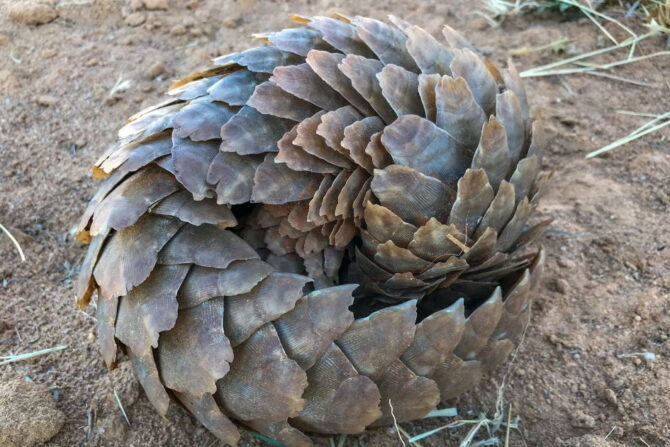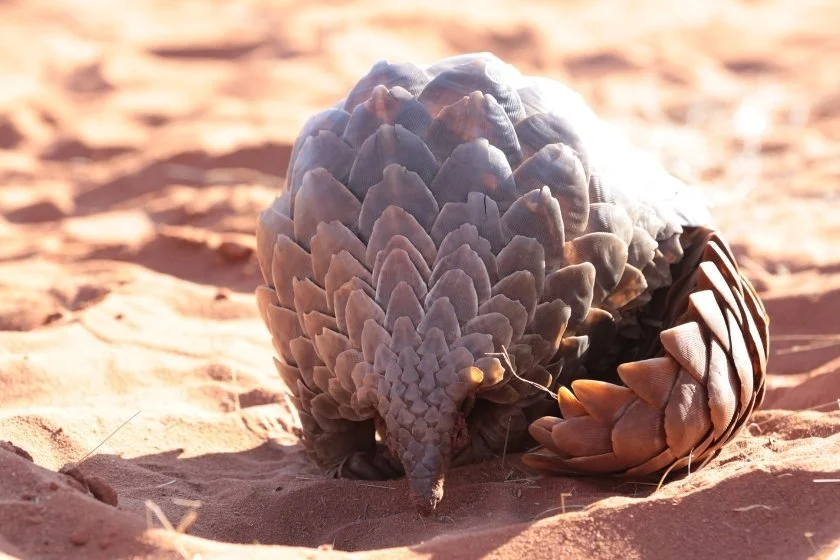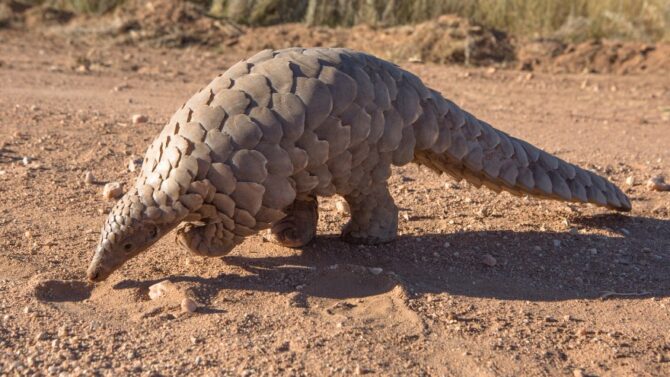Pangolins belongs to a group of mammals of the order Pholidota. In the order, there is just one extant family—Manidae—and three genera, the Manis, Phataginus, and Smutsia.
They are the only mammals with scales. This animal is also called the scaly anteater, with a couple of species still in existence and struggling to remain so. A few have gone extinct.
The pangolin is highly trafficked and as a result, is protected in many countries. If you don’t hear much about them, this could be why.
Their unusual scales attract the attention of opportunists, which has caused a drastic population decline. Thankfully, they’re still in existence and spread across some continents.
Read on to find out more.
Scientific Classification
- Kingdom: Animalia
- Phylum: Chordata
- Class: Mammalia
- Mirorder: Ferae
- Clade: Pholidotamorpha
- Order: Pholidota
- Family: Manidae
- Genus: Manis, Phataginus, and Smutsia
Characteristics
- Length: 1ft to 3ft
- Weight: 3.5 to 73 pounds
- Venom/Poison: No
- Skin Type: Scales
- Habitat: Various
- Range: Asia, Africa
- Diet: Insectivore
- Life span: Unknown
- Gestation Period: 68 to 139 days
- Conservation status: Endangered
5 Interesting Facts About Pangolins
1. They are the most trafficked animals on the planet
Pangolins are attractive because of their unique skin, but unfortunately, that’s not always a good thing.
Their scales and meat are highly sought after, which increased the rate of hunting and poaching. The scales and claws are good ingredients in traditional medicine, further increasing demands.
This is why they’re under protection by the Convention on International Trade in Endangered Species of Wild Fauna and Flora (CITES).
This has helped curtail the trafficking, but one can’t be sure there aren’t some illicit activities still going on. This can even be encouraged by the internet.
2. They roll up when threatened

This is a defense tactic these animals use to evade predators, and it works for many animals.
Like hedgehogs, they roll up into a ball when facing a threat. The name “pangolin” actually means “one who rolls up”, a nod to this ability.
Predators often get confused when a pangolin rolls and the scales might even injure them.
These bigger animals tend to leave pangolins alone. However, rolling over doesn’t protect them from humans, their biggest threat.
3. They have very long tongues and no teeth
Pangolins have tongues that are longer than their bodies, similar to many animals that feed more on insects.
These tongues are sticky, making it easy for them to trap as many insects as possible. The length also enables them to get deep into ant nests.
The tongue also covers the teeth, which they have none of. Pangolins lack teeth because they don’t need them. Their diet only requires a tongue, and they swallow the meal.
4. There are eight species of pangolins in existence
There currently exists only eight species in our world today, and others have gone extinct.
These species are evenly distributed between Africa and Asia, the only places these animals can be found in the wild.
All eight species face threats of decline, with two being listed as critically endangered. Because of protection and the numbers in captivity, we can’t be sure of the exact population.1
5. They aren’t related to anteaters

While they are sometimes called scaly anteaters, the pangolin is not related to ant-eating animals like the armadillo and anteaters. They are related to carnivores, despite the difference in diet.
General Description

The pangolin has a lot of nicknames. It is also called the scaly anteater, walking pinecones, artichokes with tails, and even modern-day dinosaurs.
All these names allude to the scaly skin. At first glance, one might erroneously classify this animal as a reptile because of its scales.
However, it is a mammal, the only scaly mammal there is. They may not look elegant or graceful, but they are unique.
Having insects as a core diet, the pangolin is adapted to hunting little creatures.
The long tail and tiny head help them get into an ant nest to trap as many as they can.
They also use their claws to grab onto trees and a tail for balance. It will be hard for any insect to escape them.
The scales are their biggest feature and the major reason they get hunted down. It is formed by clumps of keratin, the same material that makes up our fingernails. If you observe closely, the pangolin’s skin is like an arranged cluster of fingernails.
The scales are more obvious in adults. Little ones have softer skin that only hardens as they grow.
This is similar to other hard-shell animals like the armadillo. The scales form the best defense against predators.
Distribution and Habitat
These mammals are distributed in both Africa and Asia, four on each continent. Here’s how they are distributed:
African Pangolin Species
- Black-bellied
- White-bellied
- Giant ground
- Temminck’s ground
Asian Pangolin Species
- Indian
- Philippine
- Sunda
- Chinese
They have a variety of habitats, often depending on the species in question. Some spend more time on trees and would often be found in areas with heavy vegetation. Others prefer the ground and won’t be biased toward trees.
Arboreal species make good use of their claws and tails to hang up on trees where they live. Their terrestrial counterparts stay in burrows.
Diet
Pangolins are insectivores, an enemy to ants. They often invade nests and grab as many unfortunate victims as they can.
While their eyesight is weak, the sense of smell covers up for any inadequacy the poor eyesight may cause. These creatures have a strong sense of smell, a tool for hunting down prey.
Besides ants, pangolins also go after termites. The latter also find themselves invaded by our insect-eating friends. Larvae of different other insects can serve as meals too.
They go after ants and termites more due to the social lifestyle of both insects. You can find a large population of ants and termites in one place, which makes the work easier for the pangolin.
Reproduction and Mating Process
Pangolins have a mating season, and due to their lifestyle, they don’t mate throughout the year.
The seasons are usually during summer or fall. Males initiate the process by leaving scent markers to draw potential mates closer.
Sometimes the male is lucky to not have any competitors. However, he may face opposition from a rival, which they settle with a fight.
Mating happens at night with the male and female meeting near a watering hole. The gestation period lasts between 70 and 140 days, depending on the species.
The number of pups being born also varies. While the African species give birth to one at a time, the Asiatic ones can get up to three.
Just like other mammals, the pups depend on their mom for a period. In the first weeks when the skin is still soft, the pup stays in the burrow.
It only starts going outdoors when the scales harden, and it rides on the mother’s back or tail.
After a few months, the young pangolin gets weaned. That’s the first step to eventual independence.
Full independence happens when the pup gets to one or two years. The mom abandons her pup (s) during this period.
Predators and Threats
Pangolins have some natural predators, though many animals tend to avoid them because of their scales. It is hard to unwrap them when they curl into a ball, and the scales injure some animals.
That being said, they get hunted down by animals like hyenas, pythons, and lions.
Humans are the biggest threat to these animals, much more than any animal. The illicit hunting and poaching have led to a drastic population decline, and even with the protective laws, one can’t be sure the animals are completely safe.
With there being no signs of an increase in population, one can’t be optimistic yet.
Concerns over their survival further increased in 2020 when it was discovered that they may have something to do with the spread of Coronavirus.2
Conservationists feared that people may go after these animals to make them go extinct and reduce the virus.
Behavior
Pangolins are shy animals, going out of their way to avoid any confrontations. They are also solitary, preferring to either remain alone or in pairs.
They only come together during mating season, and you may find a mother with her children. They are mainly active at night, usually sleeping during the day.
The long-tailed pangolin is an exception. This species can be active during the day as well as at night.
Because they stay both on trees and land, they carry out most of their activities in both areas, including hunting.
The arboreal species hunt mainly on trees while their terrestrial counterparts stay on the ground.
As already mentioned, these animals curl into balls when attacked, a tactic that works for many predators, but not humans.
The scales can be strong enough to withstand bullets, but this animal is not completely bulletproof.
Male vs Female
Similar to many mammals, males are bigger than females. The difference in size is noticeable as the male is around 40% more than the female.
This is the most obvious distinction between both sexes. They also have different organs.
Another difference lies in the behavior. Males initiate the mating process, but not the way other mammals would.
They’d mark territories so the scent will attract the female to look for them. Males also tend to be more aggressive towards themselves, as is evident in their rivalry over a mate.
Frequently Asked Questions
Do pangolins lay eggs or give birth?
Pangolins are mammals, and they give birth and live just like others of the same type. These creatures do not lay eggs, nor do they give birth to many babies at once. Their birth ranges from 1 to 3 pups.
Are pangolins related to both cats and dogs?
While people think otherwise, pangolins are more related to cats and dogs than they are to armadillos and anteaters. Despite the resemblance, they are not related to the latter animals.
Are pangolins reptiles?
Pangolins are mammals, not reptiles. Their skin can indeed get someone confused, but that’s because these creatures are the only mammals with scales.
Wrap Up
Pangolins are sadly the highest-trafficked mammal, but there’s still hope of them not going extinct with the protective laws surrounding them.
These animals have their quirks and uniqueness, the biggest of which is the scaly skin.
References & Notes
- Giavanna G. The fight to stop pangolin extinction. via WWF.
- Agence France-Presse (2020). Pangolins may have spread coronavirus to humans. The Guardian.

